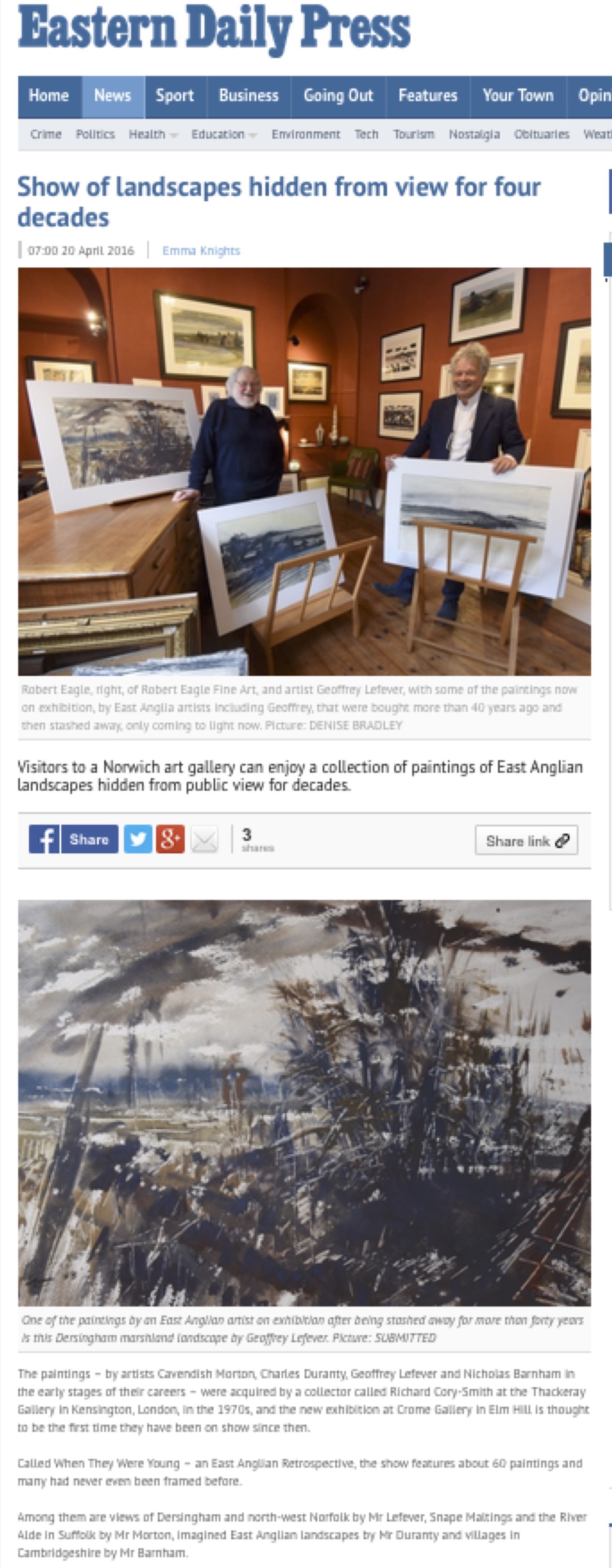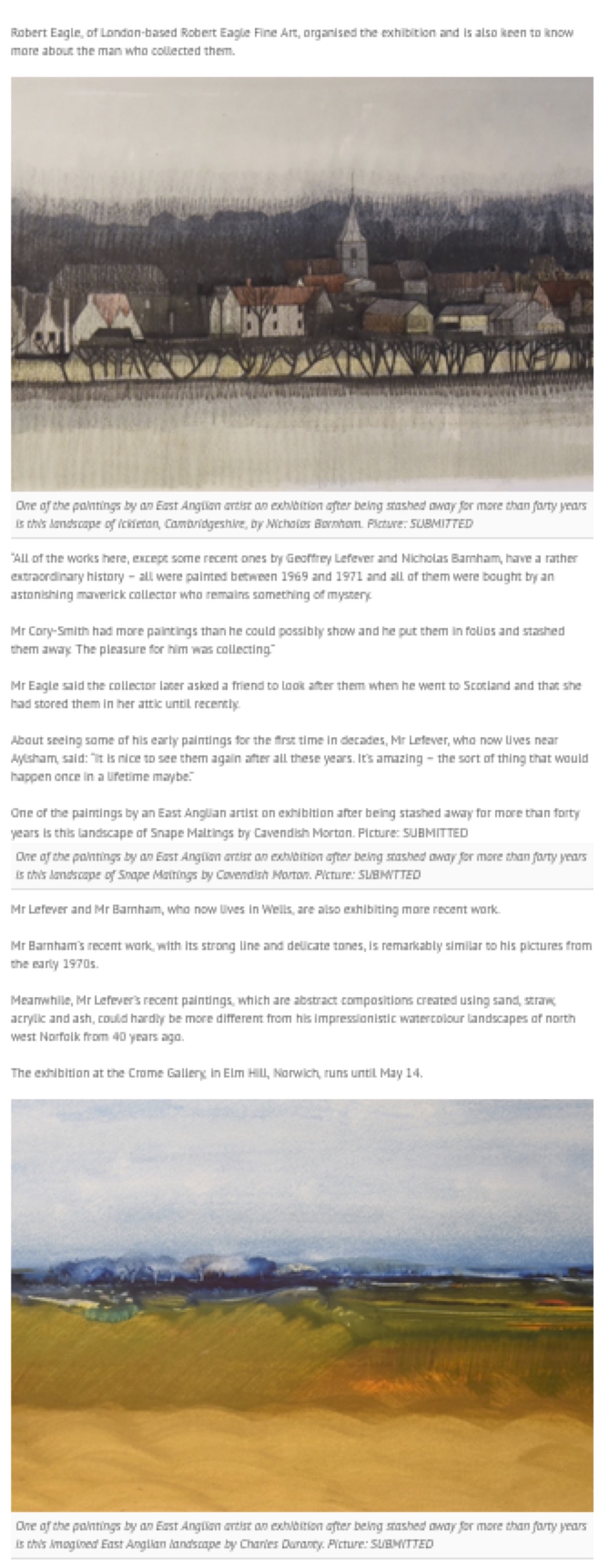News | From the archive: When they were young exhibition 2016, featuring rediscovered works by four East Anglian artists
From mid-April we are exhibiting a unique collection of East Anglian landscapes with a most unusual history.
The paintings in this exhibition were almost all created over a period of just two years between 1969 and 1971. The artists who painted them are now well known, but the paintings themselves have never been exhibited before.
Around 1970 the four artists – Cavendish Morton, Charles Duranty, Geoffrey Lefever and Nicholas Barnham – were all working in their own distinctive styles, inspired by the East Anglian landscape. Morton and Duranty were already quite well established; Lefever and Barnham were just starting their career, and all of them were represented by the Thackeray gallery, which had recently opened in London, specialising in contemporary British art.
One of the gallery’s early patrons was an avid maverick collector called Richard Cory Smith. He came from an affluent background, and over a short period he had been building up a substantial collection of British contemporary art. He often bought several pictures at a time, more than he could ever display in his own home. And after acquiring them he fell into the habit of offering them to institutions and government departments, or simply giving them away to friend and acquaintances.
This is what happened to the paintings we are exhibiting now. It seems that Cory Smith acquired all of them in the course of just a few visits to the gallery. They weren’t framed or even mounted. Cory Smith bought them, stashed them away in portfolios – and did absolutely nothing with them….
Until about 20 years later when he presented them to a friend, a lady who is now a member of the House of Lords. But she had even less room to display them. So the pictures remained in their portfolios, unseen, all but forgotten, until last year when the lady decided to move house – and asked us if we could do anything with them.
While all four artists have made their name in the intervening decades, Richard Cory Smith remains a man of mystery, even to the artists whose work he bought and the people to whom he gave away his pictures. Our research continues, but just about the only thing we know for sure is that Richard Cory Smith died in Crieff, Scotland in 2007, aged 77.
Two of the four artists, Geoffrey Lefever and Nicholas Barnham, are still very much active. We are including some of their recent works to compare and contrast with those of four decades ago.
The exhibition opens on April 15th at theCrome Gallery, 34 Elm Hill, NorwichNR3 1HG
We would like to thank Iain Pusey of Crome Gallery for his help in mounting and framing these pictures for their first public exhibition and for the use of his characterful, historic premises at 34 Elm Hill.


,
,
The Guardian obituary of Charles Duranty (January 18th 2006)
Poet and painter with an eye for East Anglican landscapes
Charles Duranty, who has died of pneumonia at the age of 87, was a poet, a publisher’s representative and a self-taught, self-deprecating painter who nevertheless sold more than 1,500 of his unmistakable water-colours over a span of 30 years. They were always imaginary East Anglian landscapes, with huge fields and somewhere a tiny animal, traction engine or human figure to give the picture a focus and, quite often, its title. One 1984 exhibit was called “I tell you it’s going to rain, it’s as plain as the nose on your face” - and yes, over the golden cornfield the sullen light of an impending storm can just be sensed.
Duranty was born in Romford, Essex, into a family which had prospered in the East India trade. His grandfather had shooting rights over 10,000 acres and a private box at Aintree, but had fallen on hard times. His father had joined the army during the Boer war and progressed up through the ranks to a commission and a Military Cross in the first world war. In civilian life he became manager of Tower Bridge wharf in London’s old dockland.
The young Charles was sent to St Lawrence college, Ramsgate, a newly created public school and he earned his place in the hockey first XI. Illness, however, left him medically unfit for military service when the second world war broke out, and he was drafted to work on a farm at Rayne, near Braintree. The farmer put him in charge of a herd of cattle, and Duranty acquired his lasting passion for the “vast cornfields and low horizons” of Essex and Suffolk.
After the war he was determined to become a poet and had verses printed in small magazines, anthologies and the Listener. This pursuit was crowned with the publication, in 1954, of a collection, Audition, which was reprinted.
Meanwhile, Duranty had set up as a freelance journalist, filing everything from art-house film reviews to the results at London greyhound tracks. He moved to more gentlemanly employment as a publisher’s sales rep. He worked for several houses, the last and longest spell with a firm whose idiosyncrasies matched his own.
This was Duckworth, housed in an old piano factory in Camden and run by the remarkable husband-and-wife team of Colin Haycraft and Alice Thomas Ellis. Their list ranged from the novels of Beryl Bainbridge, who had been an employee before she burst into print herself, to learned tomes on animal husbandry and ecology. By now a celebrated character in the book world, Duranty airily left the provinces to others. He would concentrate on the bookshops he knew and liked in London. Somehow he succeeded in persuading them to order the most daunting of offerings - one on Sheep and Man weighed in at 4lb - and both the Haycrafts and Bainbridge held him in high esteem.
In 1953 Duranty had married Vivian Marguerite Hadaway, a Canadian he first glimpsed waiting at a bus-stop. He maintained that a career as an artist only occurred to him when, in 1962, he and Vivian moved into their newly built house in Merrow, near Guildford, and he had no money to buy pictures for the walls. Though he had been thrown out of art classes at school, he declared he would paint some himself.
He started as he would go on, working from memory and imagination, putting on the paint with all sorts of improvised brushes, rags and pallet knives, and steadfastly buying cheap, students’ colours. In due course he was invited to participate in an exhibition of Seven Surrey Artists in Guildford; to his surprise, he sold three paintings, and turned professional overnight.
In London, he exhibited at Roland Browse & Delbanco and Heal’s Mansard Gallery. He was a regular in the annual Artists of Today and Tomorrow shows mounted by the New Grafton, where he had a one-man show in 1970. He also had one-man’s at the Leicester Galleries (1969), Heal’s Mansard Gallery (1970) and at the Thackeray, in Kensington, regularly between 1971 and 1992. He liked to mutter that his high sales were due to his prices being lower than those of other artists, but it was mainly because he turned out a higher proportion of small works, some only a few inches square. His work is represented in private collections all over the world, one or two public galleries in Britain and in the Government Art Collection.
In 1992 he ceased painting as abruptly as he had begun, devoting himself instead to his remaining passions - cultivating his garden and continuing his pretence at being a curmudgeonly old pessimist. In truth, he was a kind and amusing fellow who kept in touch with his friends through long letters in immaculate italic script. He enjoyed good pubs and food, and though he claimed to hate travel, he and Vivian never missed their annual visit to Aldeburgh.
His pictures hang in the Wentworth hotel there and Vivian, who died in 2000, is commemorated by a seat in the grounds. They had no children.
Philip Purser The Guardian January 18th 2006